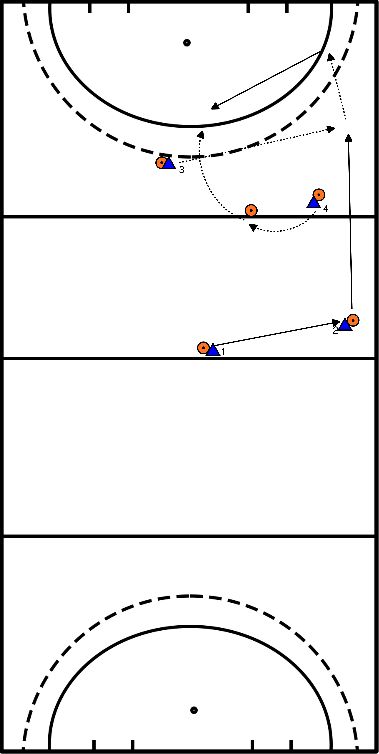Hockey drills for technique push pass
Purpose
: Various technical forms to warm up.
Format
:The exercise can be set up one-sided or two-sided. This depends on the number of players in the training.
- At point A, the player makes a drag and passes the pawns. Then he passes to the player at point B.
- The player at point B takes the ball and dribbles to point C. From there he passes to the player at point C.
- The player receives the ball and turns towards the goal, completing the pass
- Before turning, you run after the ball. Point D rejoins point A again.
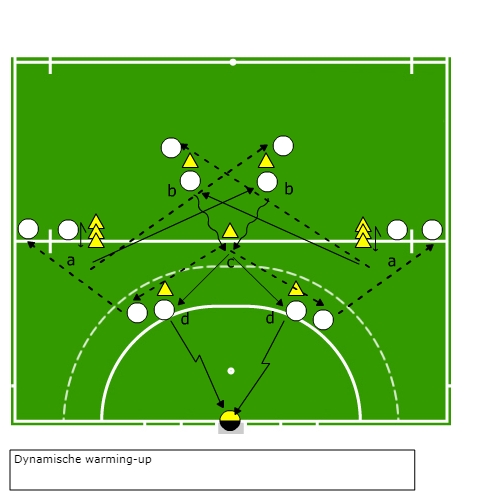
Variations:
- You can set up the exercise single-sided and double-sided.
- You can also choose to warm up the goalkeeper in this way.
- At C, you can switch sides. If you are coming from the right, play the ball to the right, so that you can practise from both sides.
Points of attention:
- This is a good time to look at different techniques of your players and polish them.
- When turning and dribbling, the ball must stay on the stick.
- There is only one point at C, so players should not get in each other's way and look for the next ball to enter play.
- All balls are played into the forehand of the teammates.
Purpose
:The purpose is to teach you how to make space for your teammates by claiming a defender to you.
Set-up:
- It looks like the player at point A is going to take the ball out, but instead of doing so he leaves the ball and runs to point C.
- At the moment that the player at A runs away, the player at point B takes over his position.
- The player with the defender at point C runs in as soon as he sees the player at point A leave the ball and run towards him.
- The ball is taken out towards point D.
- At point D the ball is taken out and played to point C. After playing the ball this player walks to point E.
- The player now at point C plays the ball to the player running to point E.
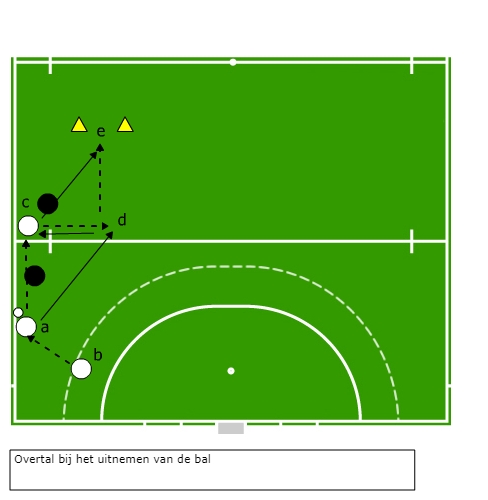
Variations:
- You can also mirror the exercise on the other side.
- When D can bounce the ball instead of taking it and playing it, the speed increases significantly.
- When C can also rebound, this increases the speed and effectiveness
- You can also give the C defender a more active role by having him try to get in front of his man.
Points of attention
- The smoother the exercise runs, the harder it is to defend it.
- Passes must be accurate for the exercise to be successful.
- Because there are many changes of position, it is important that you explain the exercise step by step.
- Player 1 plays the ball with a hard push into the attacker who has come running from the spot.
- The attacker takes the ball strongly and passes it back.
- Player 1 plays the ball to the side.
- The player on the side plays the ball directly to the corner.
- Now the team can shift via the left.
Finish the training with a match shape on a half pitch
You can adjust the width of the field depending on the size of your team at the training.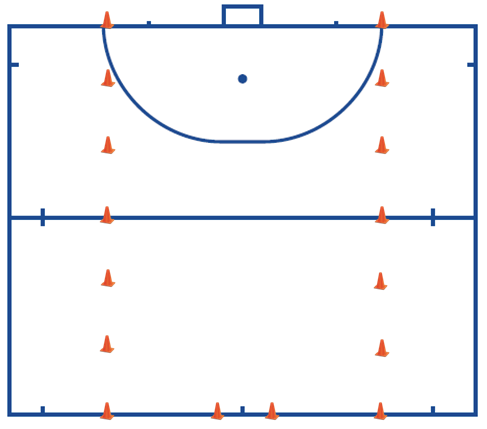
- Expansion to practice with the tip-in.
- Furthermore, it is practiced with the hard and pure pass to each other.
- A pushes the ball to B on the forehand pay attention to the technique (hands apart, left foot in front, force from all over your body, arms moving in the direction you are going).
- B pushes the ball back to A
- A pushes to C, C back to A
- A pushes to D and D back to A
- When B has played the ball back to A he turns around and goes around the pilon and calls to receive the ball.
- A takes the ball from D and gives a hard pass towards E.
- E makes eye contact with the incoming B and gives a directed pass (may be push or pass).
- B takes the ball open, aligns it up and finishes with a hit on goal.
- After shooting, he accelerates around the pilons to run a tip-in ball. F makes eye contact with B and gives a hard targeted pass just as if he is going to score. B causes the ball to change direction.
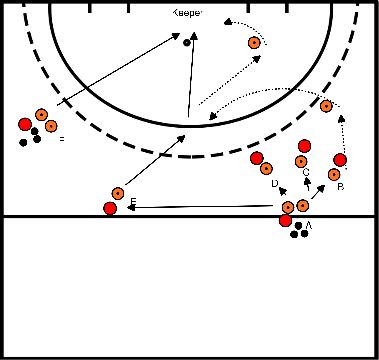
- Goal: to show the player when it is best to pass and when it is best to push.
- In case of a long pass you pass, in case of a short pass you push.
- Player 1 passes (long pass) the ball to player 2
- Player 2 pushes (short pass) the ball to player 3.
- Player 3 passes (long pass) the ball to player 4.
- Player 4 pushes (short pass) the ball to player 5.
- Player 5 passes (long pass) the ball to player 6.
- Player 6 pushes (short pass) the ball to player 7.
- Player 7 runs along the red pilons to the back line and passes (long pass) the ball to player 8, who has entered the circle.
- When explaining the exercise, you can let the player fill in whether it's a long or short pass and what kind of stroke you use, this way they will actively think about it and will apply it earlier in the game.
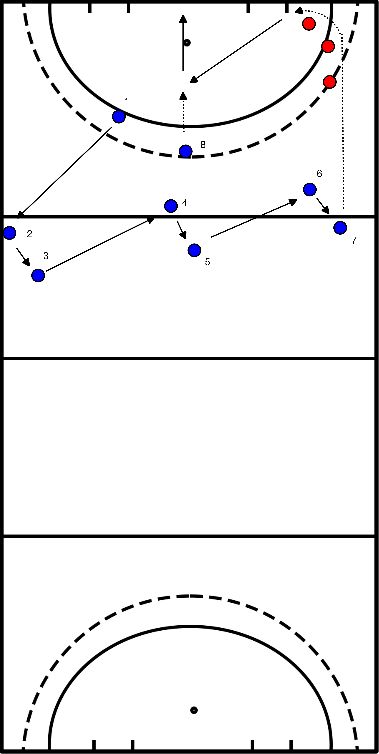
- Exercise with a buildup over right with tip-in variation in it.
- A Wants to play a free ball and there is a lot of pressure at the front. So the ball is played back to B
- B takes the ball while running makes eye contact with the running C which takes the ball and makes eye contact with the running A again.
- A takes the ball open and floats with the ball on the stick at a high speed towards the back line.
- Makes eye contact with the passed C and gives a 90 degree pass in advance.
- C takes the ball and lines the ball up and round with a hit on goal, A stands there active to tip the ball if necessary.
- Next to C, A is immediately ready for the tip of the ball coming from D.
- D has a hard targeted flats just as if he wants to score. A causes this ball to change direction and go into the goal.
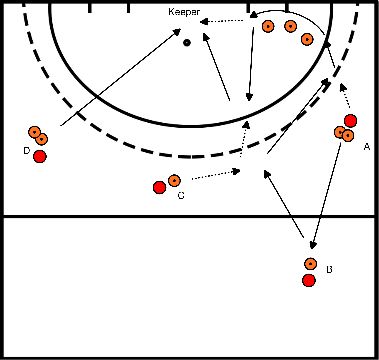
- Extension to practice with the tip-in.
- Furthermore, it is practiced with the hard and pure pass to each other.
- A push the ball to B on the forehand pay attention to the technique (hands apart, left foot in front, force from all over your body, arms moving in the direction you are going).
- B push the ball back to A, A push to C C back to A, A push to D and D back to A.
- When B has played the ball back to A he turns around and goes around the pilon and bids to receive the ball.
- A takes the ball from D and gives a hard facing flats towards E.
- E makes eye contact with the incoming B and gives a directed pass (may be push or flats).
- B takes the ball open, aligns it up and finishes with a hit on goal.
- After shooting, he accelerates towards the goal to run the tip-in.
- F makes eye contact with B and gives a hard targeted pass just as if he is going to score.
- B causes the ball to change direction.
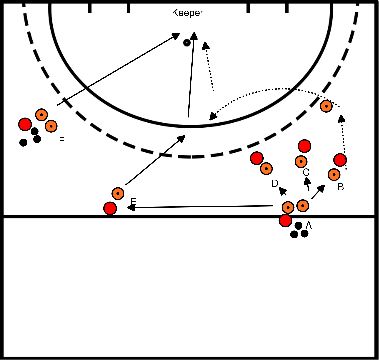
- A pass the ball with a push in the forehand of B
- B takes the ball open and passes the ball to C
- C takes the ball open and passes the ball to D
- D takes the ball open, makes eye contact with E
- E comes running towards the ball and takes the ball while running and turns to the right with the ball on the stick.
- E makes eye contact with F
- F runs into the ball and gets the ball from E who gives a hard push in the forehand
- F takes the ball in the barrel turning to the left and dribbles with the ball on the stick into the circle and aligns the ball or strikes goal.
- G can be added later in the exercise if the exercise goes well
- This runs before the tip-in of F
- This runs before the tip-in of F
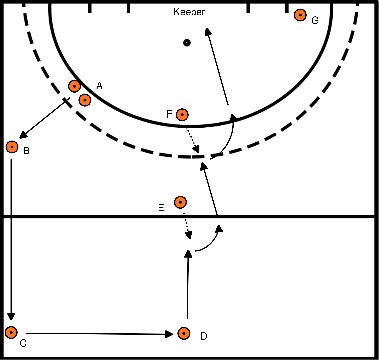
- A drives the ball with the stick into the circle, aligns the ball up and finishes at goal. At the bottom between, B dribbles with the ball on the pilon with the ball on the stick.
- B makes eye contact me A and gives a 90 degree pass on the forehand of A (preferably with a push)
- A picks up the ball on line and finishes at goal
- B runs after hitting the second ball from A towards C
- C gives a hard pass towards the circle
- Like he wants to score
- B uses a tip-in to change the direction of the ball and enter the goal (walk through the ball, let stick point in the direction you want the ball to go).
- You are running from
- A to B
- B to C
- C to A
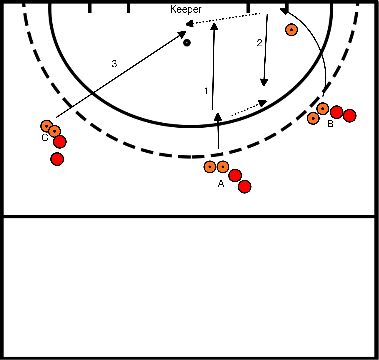
- Player 1 walks to the right pole of the goal
- Player 2 plays the ball towards the blue pilon and allows player 1 to tip the ball in the loop.
- Player 2 runs to the left pole of the goal
- Player 3 plays the ball towards the red pilon and allows player 2 to tip the ball in the loop
- By swapping:
- 1 --> 2
- 2 --> 3
- 3--> 1
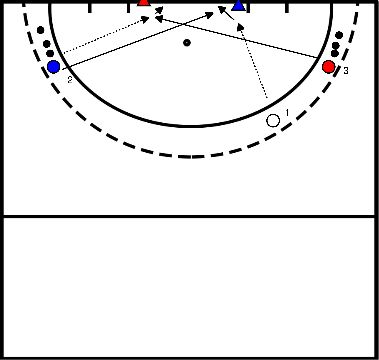
- The game starts with a pass from player 1 to player 2
- Player two gives a clean pass along the line
- Whereupon player 3 runs towards the line to receive the ball with a backhand
- Player 4 runs along the pilon and positions himself on the top of the circle or continues running by the tip.
